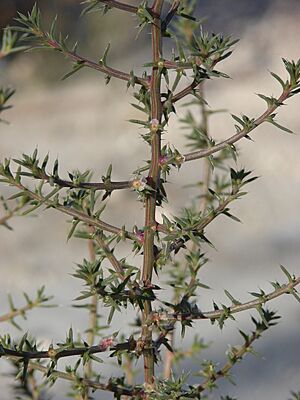List of invasive plant species in Nevada facts for kids
Nevada is a beautiful state with many unique plants and animals. But sometimes, plants from other parts of the world are brought here. These are called introduced species or non-native plants. While many introduced plants are harmless, some can become a big problem. When they spread quickly and cause harm to the environment, they are called invasive species. Nevada has quite a few of these invasive plants.

Contents
What are Invasive Plants?
Invasive plants are like bullies in the plant world. They are not originally from a certain area, but they arrive and take over. They grow very fast and spread easily. This makes it hard for the native plants, which have lived there for thousands of years, to survive.
Why are Invasive Plants a Problem?
Invasive plants can cause many problems for Nevada's natural areas:
- They steal water and nutrients from native plants. This can make native plants sick or even kill them.
- They change the soil and how fires spread. Some invasive plants can make fires worse or more frequent.
- They reduce food and homes for native animals. Many animals depend on specific native plants for food and shelter.
- They can even change how water flows in rivers and streams. This affects fish and other water creatures.
How Do Invasive Plants Get to Nevada?
Invasive plants can arrive in Nevada in many ways. Sometimes, people bring them on purpose for gardens or farms. But then the seeds escape and spread into the wild. Other times, they arrive by accident. Seeds can stick to cars, clothes, or even animal fur. They might also travel in contaminated soil or hay.
Common Invasive Plants in Nevada
Many different types of plants have become invasive in Nevada. Here are a few examples:
- Giant Cane (Arundo donax): This plant looks like a giant bamboo. It can grow very tall and forms thick patches along rivers and streams. It uses a lot of water and pushes out native plants that provide food for wildlife.
- Prickly Russian Thistle (Kali tragus): You might know this as a "tumbleweed." It's a very common plant in Nevada's deserts. When it dries out, it breaks off and rolls, spreading its seeds everywhere. It can quickly cover large areas.
- Tamarisk (Tamarix species): Several types of tamarisk, like French tamarisk and saltcedar, are invasive in Nevada. They are shrubs or small trees that grow along waterways. They use a lot of water and release salt into the soil, making it hard for other plants to grow.
- Bromegrasses (Bromus species): Several types of brome, like great brome and drooping brome, are invasive grasses. They can spread quickly, especially after fires, and outcompete native grasses and wildflowers.
See also
- Invasive species in the United States
Images for kids





















